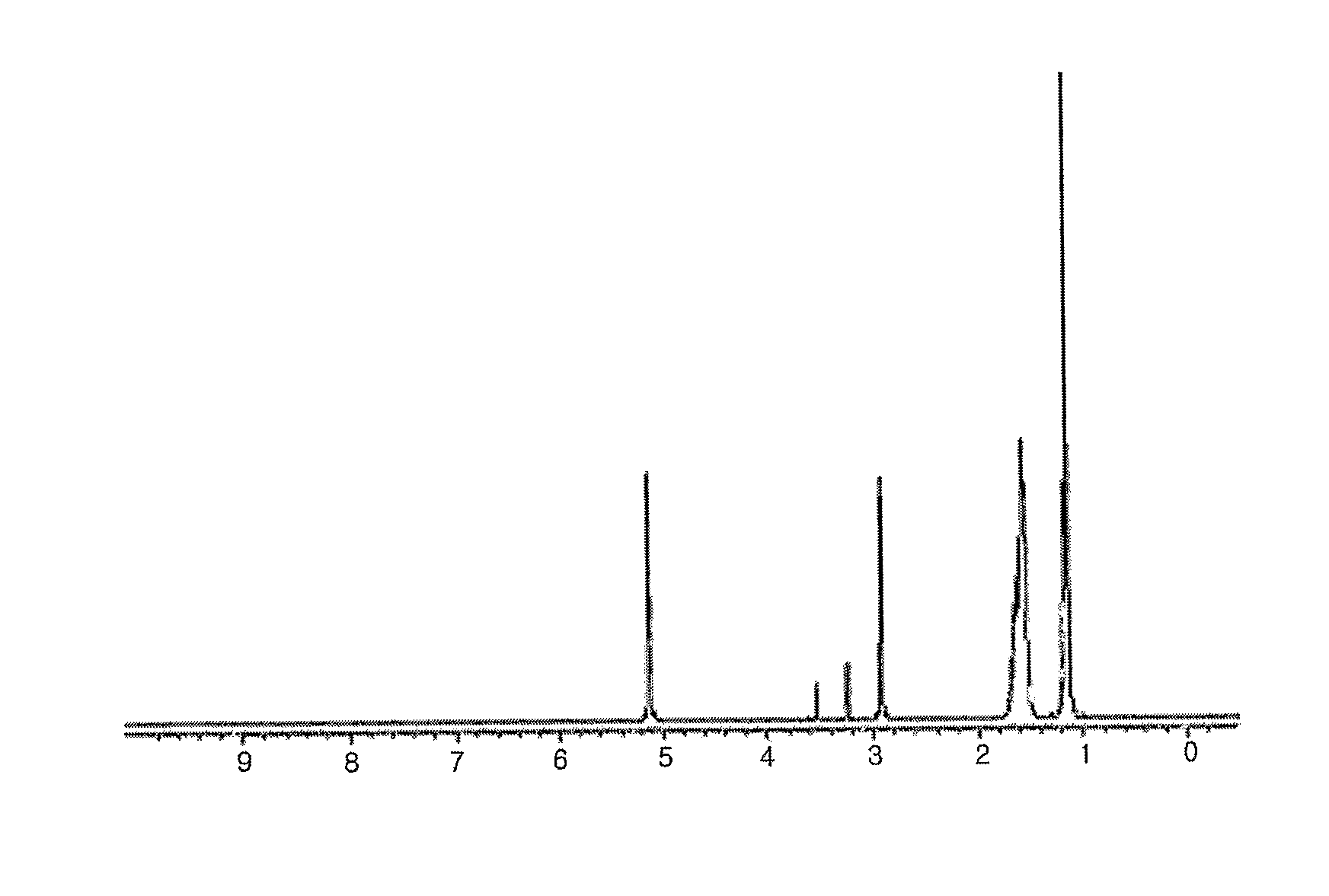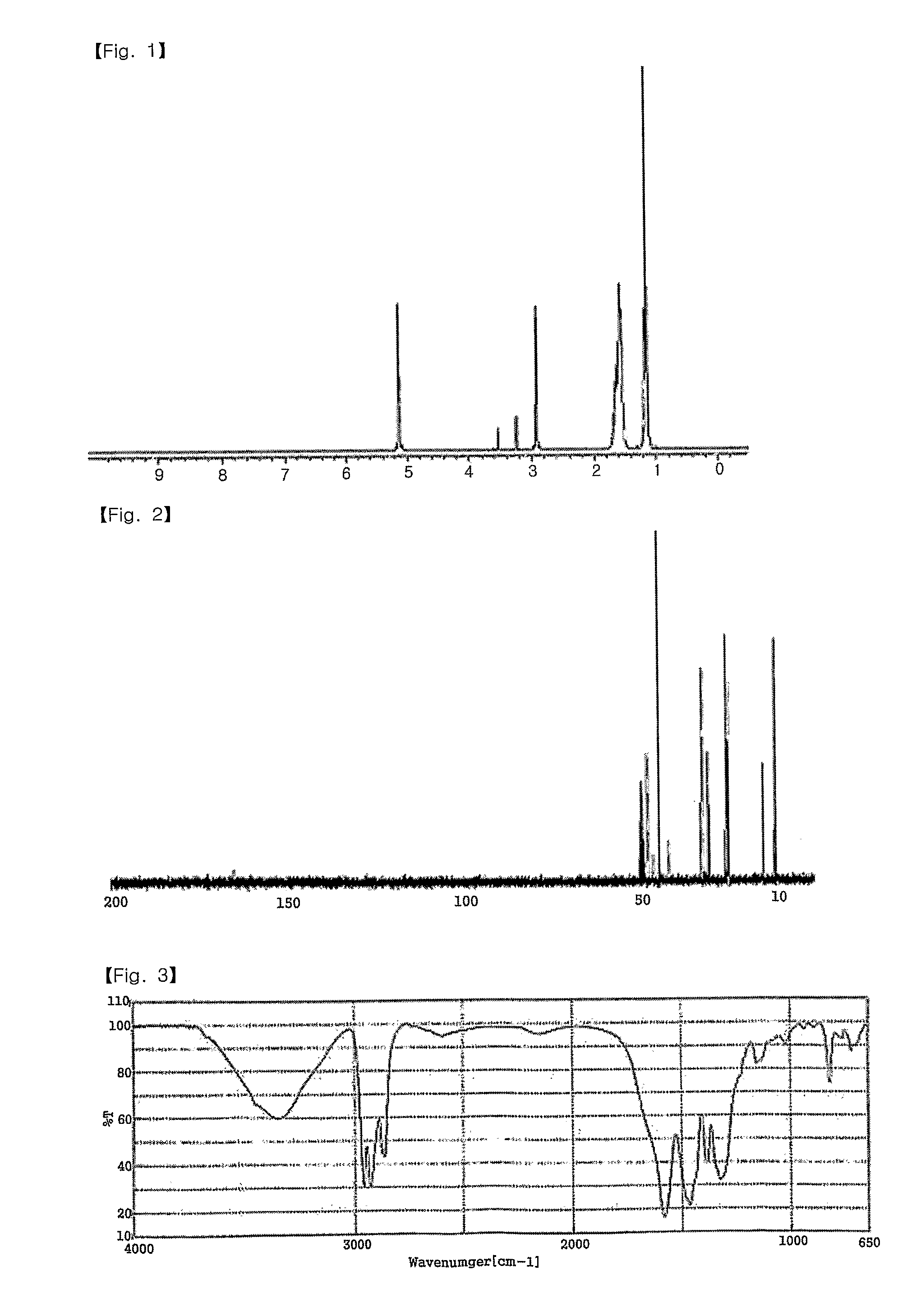Organic silver complexes, their preparation methods and their methods for forming thin layers
a technology complexes, applied in the field of organic silver complexes, can solve the problems of limited application, insufficient stability or solubility of silver derivatives known so far, and high decomposition temperature to be applied, and achieve the effect of superior stability and solubility and easy preparation
- Summary
- Abstract
- Description
- Claims
- Application Information
AI Technical Summary
Benefits of technology
Problems solved by technology
Method used
Image
Examples
example 1
Reaction of Silver Oxide with 2-ethylhexylammonium 2-ethylhexylcarbamate
[0044]In a 50 mL Schlenk flask equipped with a stirrer, 3.25 g (10.75 mmol) of 2-ethylhexylammonium 2-ethylhexylcarbamate (viscous liquid) was dissolved in 10 mL of methanol. 1.0 g (4.31 mmol) of silver oxide was added and reaction was performed at room temperature. The reaction solution was initially a black slurry but it turned transparent as complex was produced. After 2 hours of reaction, a colorless, transparent solution was obtained. The resultant solution was filtered with a 0.45 micron membrane filter to remove unreacted silver oxide. Then, the solvent was removed at vacuum to obtain white solid. The solid was recrystallized in ethyl acetate, dried and weighed to obtain 4.22 g of a silver complex (yield=99.4%). The silver complex had a melting point of 57-58° C. (DSC=57.26° C.) and a silver content of 22.0 wt % (TGA analysis).
[0045]1H NMR (CD3OD, ppm), 1.11-1.19 (m, —CH3) 1.51-1.69 (m, —CH2, —CH), 2.91-2...
example 2
Reaction of Silver Oxide with n-Propylammonium n-Propylcarbamate
[0046]In a 50 mL Schlenk flask equipped with a stirrer, 1.74 g (10.75 mmol) of n-propylammonium n-propylcarbamate (viscous liquid, melting point: 74-76° C.) was dissolved in 10 mL of methanol. 1.0 g (4.31 mmol) of silver oxide was added and reaction was performed at room temperature for 2 hours while stirring. A colorless, transparent complex solution was obtained as in Example 1. The resultant solution was filtered with a 0.45 micron membrane filter to remove and the solvent was removed at vacuum to obtain white solid. The solid was dried and weighed to obtain 2.42 g of a silver complex (yield=88.3%). Most of the silver complex was decomposed below 130° C. to leave metallic silver. The silver content was 38.4 wt % (TGA analysis).
[0047]1H NMR (CD3OD, ppm), 0.98-1.02 (t, —CH3) 1.59-1.65 (m, —CH2), 2.76-2.80 (t, —NCH2), 13C NMR (CD3OD, ppm), 47.03, 27.84, 11.53
example 3
Reaction of Silver Oxide with Isopropylammonium Isopropylcarbamate
[0048]In a 50 mL Schlenk flask equipped with a stirrer, 1.60 g (10.75 mmol) of isopropylammonium isopropylcarbamate (white solid, melting point: 78-80° C.) was dissolved in 10 mL of methanol. 1.0 g (4.31 mmol) of silver oxide was added and reaction was performed at room temperature. The reaction solution was initially a black slurry but it turned transparent as complex was produced. After 2 hours of reaction, a colorless, transparent solution was obtained. The resultant solution was filtered with a 0.45 micron membrane filter and the solvent was removed at vacuum to obtain white solid. The solid was dried and weighed to obtain 2.48 g of a silver complex (yield=95.5%). Most of the silver complex was decomposed below 130° C. to leave metallic silver. The silver content was 37.2 wt % (TGA analysis).
[0049]1H NMR (CD3OD, ppm), 1.13-1.22 (d, —CH3), 3.22-3.31 (m, CH), 13C NMR (CD3OD, ppm), 45.78, 26.06
PUM
| Property | Measurement | Unit |
|---|---|---|
| melting point | aaaaa | aaaaa |
| melting point | aaaaa | aaaaa |
| melting point | aaaaa | aaaaa |
Abstract
Description
Claims
Application Information
 Login to View More
Login to View More - R&D
- Intellectual Property
- Life Sciences
- Materials
- Tech Scout
- Unparalleled Data Quality
- Higher Quality Content
- 60% Fewer Hallucinations
Browse by: Latest US Patents, China's latest patents, Technical Efficacy Thesaurus, Application Domain, Technology Topic, Popular Technical Reports.
© 2025 PatSnap. All rights reserved.Legal|Privacy policy|Modern Slavery Act Transparency Statement|Sitemap|About US| Contact US: help@patsnap.com



